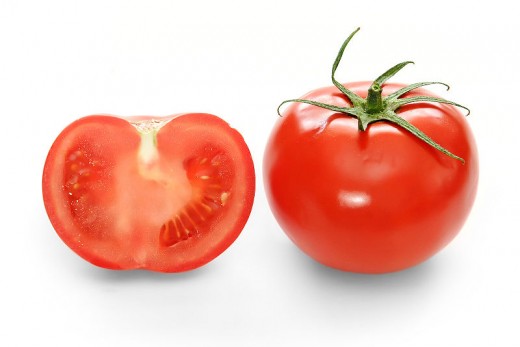What are the Benefits of Tomatoes
Who Grew the First Tomtato?
Actually tomato started as a common weed in South America. It is thought that the tomato started as an edible food source in the plains of Peru. At that time the fruit (berry) was likely a small yellow orb similar to the cherry tomato today. Aztec writing mentions the tomato in a recipe that included peppers, corn, and salt.
Archeological evidence indicates that the Aztecs began forming city states in the thirteenth century, though it is quite possible that the tomato, as a food, is much older. Currently science thinks the tomato was used as food as far back as 500 B.C.
The Aztec called this fruit tamtl and the Spanish derived the name tomato from the Aztec pronunciation.

History of the Tomato as Food
The tomato plant is a member of the nightshade family. A plant, known in Europe during the time of the Spanish Conquest of South America as a poisonous plant.
It is not known whether Cortez or Columbus brought the tomato plant back to Spain, though the majority of historians think it was Cortez.
Whoever brought the tomato to Europe it spread rapidly. Along the route back to Europe the tomato was planted in the Caribbean, the Philippines, and Southeast Asia. Because the tomato grows readily in Mediterranean climates it did not take long for it to appear in Iran and other middle-eastern countries.
The tomato made it's first appearance in Britain at around 1700 when cultivars were introduced that fared better in colder climates. Oddly the tomato did not make an appearance in the Americas until Thomas Jefferson sent seed back to the states from Paris.
Tomatoes have a long growing season and thrive in high heat. For that reason the two states in the United States growing tomatoes as a cash crop were Florida and California.
As a gardener grown food item the tomato is one of the most popular in the United States with a reputation for producing more edible fruit than the grower needs.
Food Benefits of the Tomato
First, tomatoes are full of lycopene, a known antioxidant. Lycopene has also been linked to a prevention of prostate problems. Men take note. Ladies lycopene has also been linked to reduced rates of breast cancer. Lycopene has also been linked to reduced incidences of head and neck cancers as well as neurodegenerative diseases. Lycopene has also been liked to better resistance to UV skin damage.
Tomatoes also produce carotene, anthocyanin, and other antioxidants. They are also rich in Vitamin C, Vitamin A, and anthocyanin (P20 Blue).
Raw Tomato Recipe
Tomato Basil Mozzeralla
- Eight medium tomatoes (I think Roma or Plum taste best)
- Three (16oz) balls fresh Mozzarella (buffalo milk mozzarella is best)
- Thirty-two basil leaves (the Hawaiian basil is quite good, but any will do)
- Salt and Pepper to taste
- Olive Oil
Preparation:
- Slice the tomatoes into 1/4" rounds
- Slice the mozzarella into 1/4" rounds
- Roll the basil leaves into a tube and slice into thin strips
- Drizzle some olive oil on a clean plate and place the mozzarella rounds evenly around the plate
- Top each mozzarella round with a slice of tomato
- Sprinkle the julienne basil on the tomato mozzarella rounds
- Drizzle olive oil on the rounds
- Spinkle with salt and pepper to taste
Eat and enjoy. The flavor combination is fantastic, the mozzarella low calorie, and the olive oil good for both your skin and digestion.
Topical Benefits of Tomato
Topical means "applied to the skin."
Tomatoes and tomato juice can be applied to the skin for a variety of beneficial effects.
Shrink Pores
Mix one tablespoon of tomato juice with 2 to 4 drops of fresh lime juice. Apply this mixture to the skin with a cotton ball. Leave on for about 15 minutes. Rinse with cool or slighly warm water to shrink pores.
Acne Treatment
Mash one whole ripe tomato to a pulp and liberally apply to the area affected by acne. Leave on for one hour. Rinse with cool or slighly warm water. Repeat this treament daily for about one or two weeks. The astringent properties of the tomato will kill bacteria.
Lycopene Mask
Acquire ten to twelve tomatoes. Bring a pot water to a boil and dip each tomato into the water for about a minute. This will loosen the skin of the tomato. Separate the skins from the pulp (set the pulp aside for something else) and apply the skins, fleshy side toward the skin. Leave the skins on for thirty to forty minutes.
After the prescribed time remove all the skins and rinse with cool or slightly warm water and pat dry. You should see almost instant results with smoother tighter skin.
Lycopene Content
Lycopene content of tomatoes varies by cultivar, but regardless of the variety more lycopene is freed from the tomato if they are cooked.







